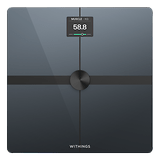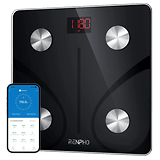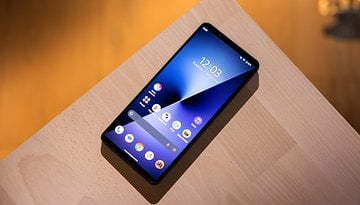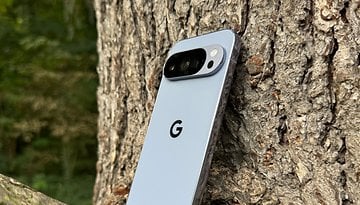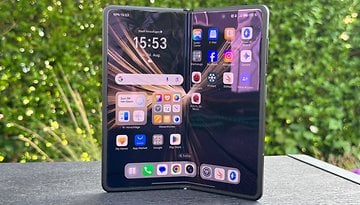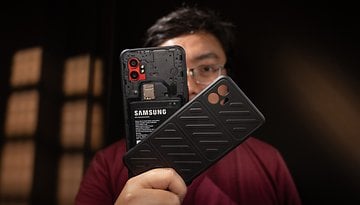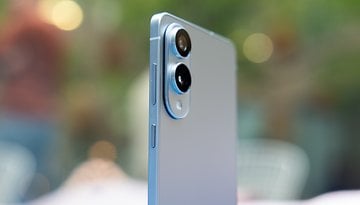Asus ROG Phone 5 review: Over-the-top and relevant
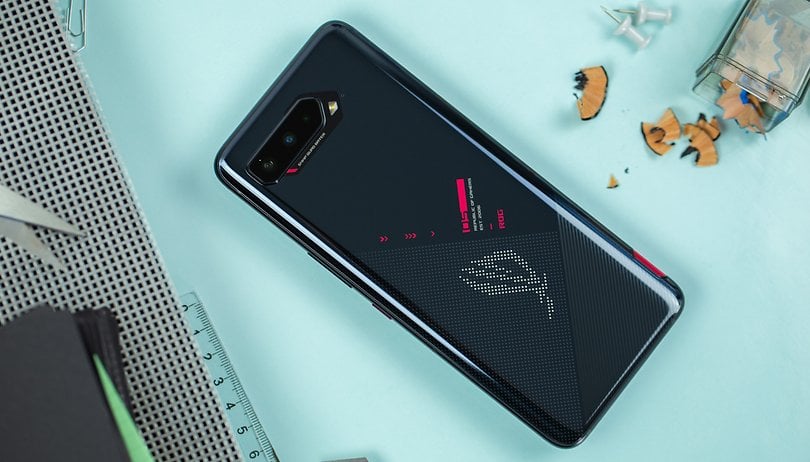

The Asus ROG Phone 5 takes the throne of the most powerful Android smartphone in the market once again. However, this begs the question: Is a gaming smartphone sold between €800 and €1,000 while targeting an extremely niche market relevant in 2021? In my opinion, I would say "Yes", and will proceed to explain my stand in this full review.
Good
- Smooth 144Hz AMOLED display
- Powerful Snapdragon 888 SoC
- Great temperature management
- Excellent battery life
- Unique, practical design
Bad
- Camera performance is average at best
- Tracking in ROG UI software
- Large and heavy form factor
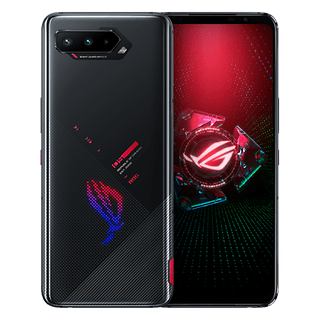
My brief opinion on the Asus ROG Phone 5
The Asus ROG Phone 5 comes in three configurations of 8/128 GB, 12/256 GB, and 16/256 GB, and will be sold at €799, €899, and €999, respectively. The Pro version is yet to see a launch in Europe while the top of the line 'Ultimate' variant would most probably be an exclusive limited edition that is made available to only a very small number of people worldwide due to the crazy €1,299 price tag.
I was able to review the 'entry level' (I use the term loosely here) version of this ROG Phone 5, which is already more powerful and cheaper than all other flagship 2021 Android smartphones such as the OnePlus 9 Pro, Samsung Galaxy S21 and Oppo Find X3 Pro.
Just like its predecessor, the ROG Phone 3, this flagship maintains a gaming smartphone identity above all else and hence offers average performance in the photography department, unlike its competitors. However, I find Asus' choice to solely focus on dishing out as much power as possible with a Snapdragon 888 SoC, 16GB of LPDDR5 RAM, a 144Hz AMOLED display, and a massive 6,000mAh battery to be worth the effort in an era where smartphones are fast becoming our main means of consuming multimedia content no matter where we are, if not having done so already.
You might be happy with your overpriced compact cameras on a smartphone, but I prefer a portable gaming machine that allows me to not only enjoy games on the go, but enjoying movies and videos while listening to music under optimal conditions without making any sacrifices.
A unique and practical design
The Asus ROG Phone 5 continues in the same vein as that of its predecessor by offering a more muted design without forgetting to pay homage to its target audience and its roots. You will no longer find the aggressive curves or the visible cooling chamber here, but rather, the back is smooth to the touch while the metal edges sport a matte shade. All of it combines together well to deliver a smartphone with a handsome personality.
In short, I liked the:
- dual USB-C ports, including 1 on the side
- 3.5mm audio jack with Quad DAC
- elegant gaming-inspired design
In short, I did not like the:
- lack of IP waterproof certification
- massive dimensions and weight
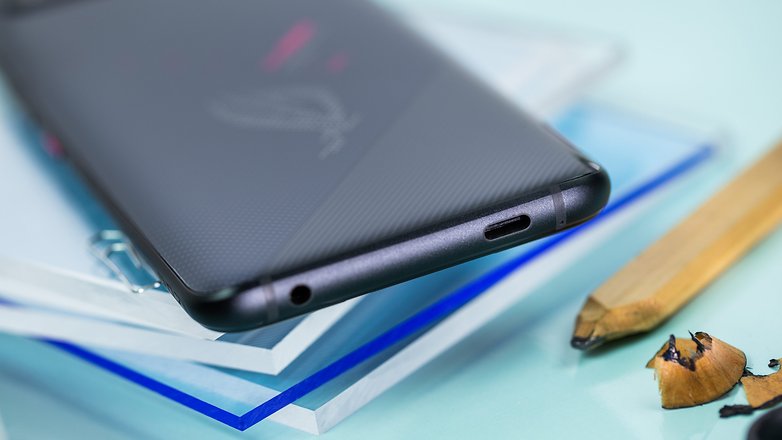
As explained earlier, the ROG Phone 5 is not a portable Christmas tree that is lit up with numerous RGB LEDs. Rather, the design takes a very "cyberpunk" route that is more muted and elegant in nature. The smooth glass back features carbon fiber-like diagonal lines and plenty of tiny dots that form the ROG logo, of which can light upon your command for that added touch of class.
What I really liked about it is the gaming spirit it suggests as opposed to "screaming" it in a visual manner. The discreet "GLHF" ("Good Luck, Have Fun", a common acronym among competitive online gaming circles) printed along the metallic red dual SIM port is a good example.

The ROG Phone 5 finally returns to a dual USB-C port configuration with one of the two ports located on the left edge, perfect for charging the smartphone while still gaming without getting all bothered by the cable. I also welcome the presence of a 3.5mm jack with a Quad DAC so that I can plug in my favorite audiophile headphones and/or earphones, listening to FLAC files without any problems.
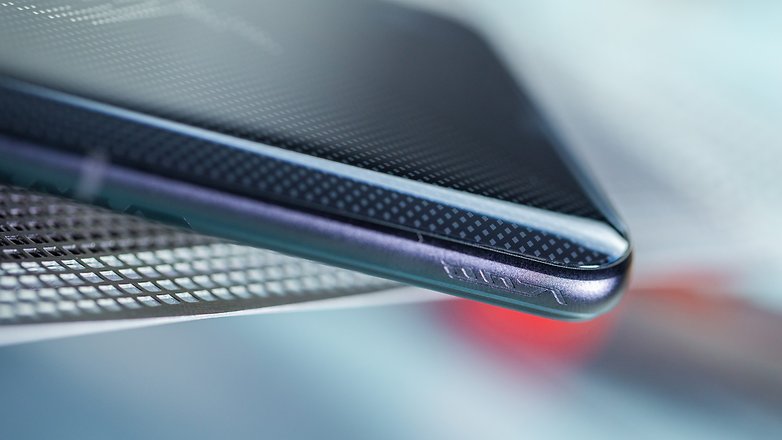
On the other hand, the smartphone is rather thick and especially heavy, tipping the scale at a massive 238 grams! The Asus ROG Phone 5 also lacks IP certification for water and dust resistance, which is strange for a flagship device. Even the SIM port lacks a silicone seal for waterproofing.
Overall, I really liked the design of the Asus ROG Phone 5. It boasts of a clean and modern look that remembers its niche target user group with a few geeky implementations.
A super smooth 144 Hz AMOLED display
The Asus ROG Phone 5 sports a 6.78-inch Samsung AMOLED panel with a 20.4:9 aspect ratio and a Full HD+ resolution of 2448 x 1080 pixels, with a 395 ppi pixel density. The flat panel also features an adaptive 144Hz refresh rate, a 300Hz touch sampling rate, and a maximum brightness of 800 nits.
In short, I liked the:
- exceptional fluidity
- responsive and precise in-game touch controls
- readable display under all lighting conditions
In short, I did not like the:
- adaptive refresh rate is not responsive enough
- lack of QHD+ resolution (but the choice is understandable)
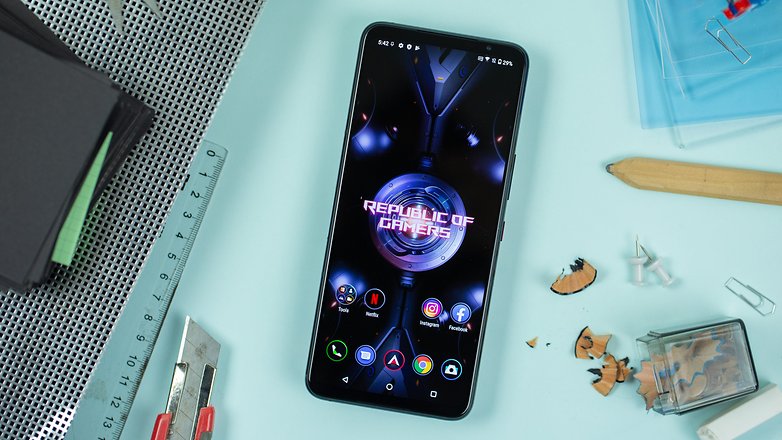
Asus has bet everything it has on the buttery smoothness of the ROG Phone 5's display. A smoothness that can be experienced thanks to its high refresh rate, high touch sampling rate, and fast response time.
Let me begin with the refresh rate. It can be set to 60, 120, or 144 Hz but remains "adaptive." This notion of an "adaptive" rate differs from one Android manufacturer to another, and the implementation might not always be relevant. As far as the system interface and each app's UI is concerned, the refresh rate will be set to whatever you select by default.
So far, so good, right? I noticed several inconsistencies such as when viewing YouTube videos. With 120 Hz set to my default refresh rate, YouTube's interface is displayed in 120 FPS, but when I launch the playback of a video, the screen switches to 60 Hz, which is normal. On the other hand, with a default 144 Hz refresh rate, the interface will indeed perform at 144 FPS, but it will be reduced to 120 Hz when playing a video. This is one choice that does not make too much sense in terms of optimizing battery life.
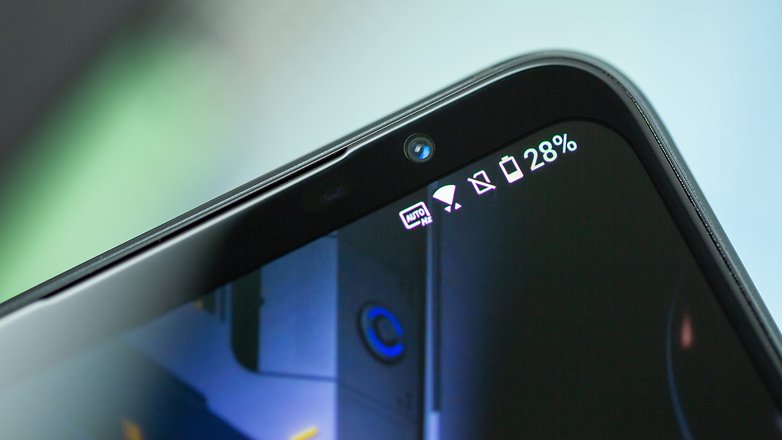
When gaming, these problems do not really arise except in the menus of certain games that are obviously locked at 30/60 FPS. And if the number of games that have adopted 144 Hz remains limited at best, playing CoD Mobile in 120 FPS or Genshin Impact in constant 60 FPS was an absolute pleasure.
Let's get to the touch sampling rate. On the ROG Phone 5, this figure was increased to 300 Hz. This translates to a display that registers each touch 300 times per second. Combine that with the 24.3ms touch latency (the delay between touch and executing a command), you end up with an advantage in multiplayer games - not much, but it is still an advantage.
I would have loved to have a better QHD+ resolution like the one found on the Samsung Galaxy S21 Ultra for example, but this choice would surely have negatively affected the ROG Phone 5's battery life. Apart from that, the display of the Asus ROG Phone 5 is exceptionally smooth for games as well as for other multimedia content.
Snapdragon 888 offers top-notch performance alongside exceptional temperature maangement
The Asus ROG Phone 5 is powered by Qualcomm's Snapdragon 888 SoC, just like many other high-end Android smartphones. It is therefore unsurprising that the Asus ROG Phone 5 delivers raw power, but it also shines when it comes to temperature management - which literally offered fantastic performance.
In short, I loved the:
- raw processing muscle of Snapdragon 888
- total absence of overheating courtesy of the external fan
- high resistance to thermal throttling
In short, I did not like the:
- X mode that fails to deliver a definite performance boost
In terms of raw performance, the ROG Phone 5 behaved like its non-gaming counterparts in the high-end segment. I chose the scores obtained with the X mode, which was supposed to boost performance, all the while running with the connected external AeroActive Cooler 5 fan (that also ups the noise level).
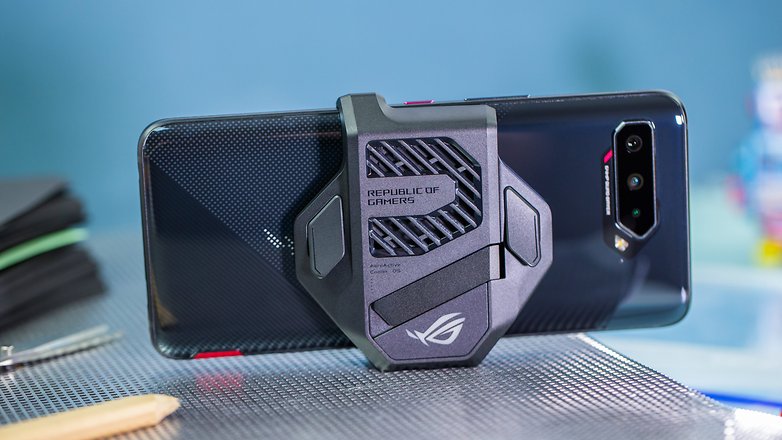
Unlike the X mode that did not deliver any concrete gain in performance, the fan proved to be very useful to limit thermal throttling. You can't really overclock the CPU in the first place, with the eight Kyro 680s arranged in a tri-cluster (1+3+4) format that pumped out steady performance at 2.84, 2.42, and 1.8 GHz speeds, respectively. It's really the gaming endurance that makes the ROG Phone 5 stand out, more than relying on raw performance figures alone.
Asus ROG Phone 5
| Benchmarks | Asus ROG Phone 5 | OnePlus 9 Pro | Xiaomi Mi 11 | Samsung Galaxy S21 Ultra |
|---|---|---|---|---|
| 3D Mark Wild Life | 5677 | 5670 | 5702 | 7373 |
| 3D Mark Wild Life Stress Test | 5669 | 5698 | 5697 | 5175 |
| Geekbench 5 (Single / Multi) | 1123/3750 | 1112/3633 | 1085/3490 | 942 / 3407 |
| PassMark Memory |
31994 | 31891 | 26.333 | 31.752 |
| PassMark disk |
119670 | 112370 | 120.430 | 81.108 |
Aside from the raw power that's readily available, the real highlight of the Asus ROG Phone 5 is its temperature management. What does this mean? Basically, the smartphone can run at higher than average temperature without having thermal throttling kick in to limit its performance, enabling it to deliver a far a more stable level of performance. This is made possible largely due to the external fan.
In 3DMark's Wild Life Stress Test, which simulates intensive gaming use, the ROG Phone 5, with X mode turned on and the AeroActive Cooler 5 connected, showed no signs of overheating at all. The performance level remained constant from the first to the last test loop. Look at the performance difference between the beginning and the end of the benchmark below (purple and green curves), it remained close to zero at all times! This is the first time I obtained such a result.
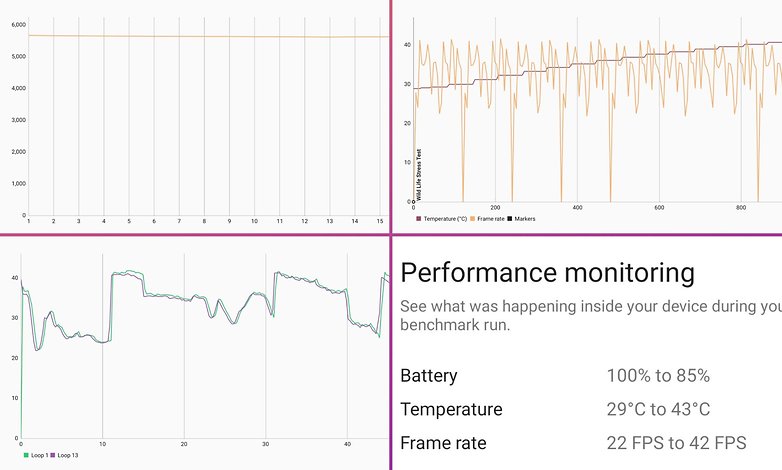
To understand the impact of temperature management, I performed the same test using the same parameters but without the external fan. Observe the clear drop in performance as soon as the temperature rose. Don't get me wrong, this is perfectly normal and is even considered as 'healthy' for the smartphone to throttle itself to limit overheating and offer a more stable framerate.
But we lost about 10 FPS compared to the test with the fan attached. The good thing is, this drop in performance (thermal throttling) is progressive and is therefore less likely to be felt by the user when gaming. Note that without the fan, I obtained better scores with the "dynamic" (i.e. balanced) performance mode than with the dedicated X mode.
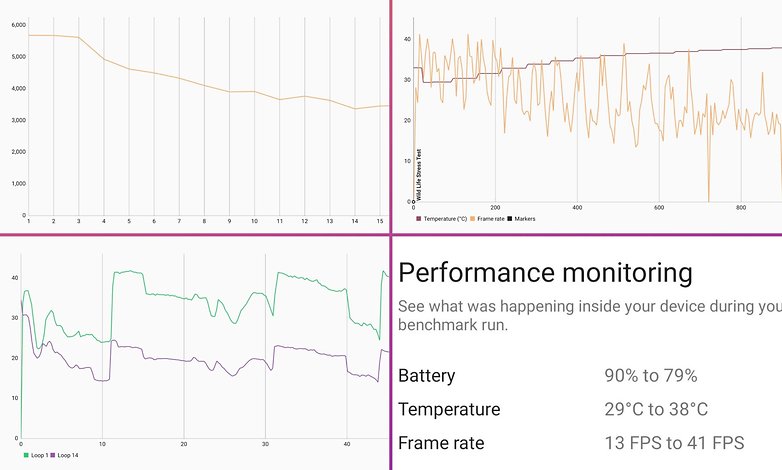
The ROG Phone 5 demonstrates here the advantage of a gaming smartphone's engineering. Rather than catering to a niche market, Asus pushed the standards in terms of performance that a flagship is and should be at. To that regard, it is a total success!
The 64 MP triple camera module leaves you unimpressed
The Asus ROG Phone 5 offers pretty much the same camera module as last year's ROG Phone 3, with a 64 MP main shooter, a 13 MP ultra-wide angle sensor, and a 5 MP macro sensor.
In short, I liked the:
- decent wide-angle daytime photos
- natural colorimetry
In short, I didn't like the:
- lack of versatility
- missing telephoto lens
- increased noise even during the day
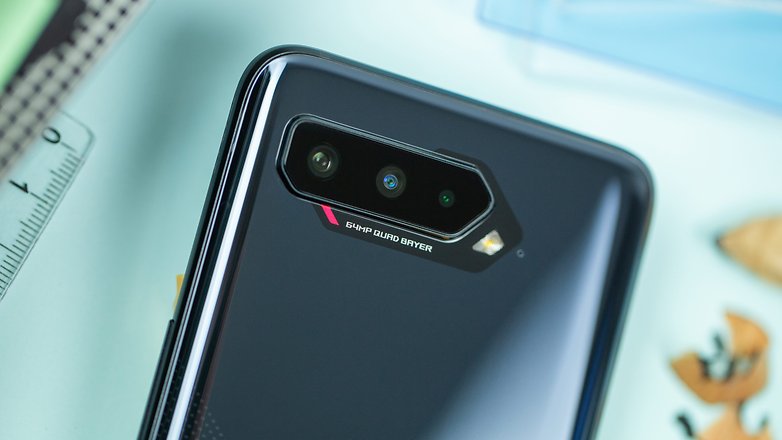
Usually, the camera section ranks among the most detailed in my smartphone reviews. This is not the case here, as I'll just invite you to revisit my ROG Phone 3 review since the captured quality is simply identical. Asus itself admitted during its keynote and press briefings that camera performance doesn't really matter on a gaming smartphone.
Personally, I don't agree with this statement, but I can understand their point of view, as investing just as much in the camera module as in performance optimization would be an unreasonable demand for a niche smartphone. This is also counterproductive since it would cannibalize the ZenFone line's market share.
I'll just make note that under bright daylight and in good lighting conditions, the ROG Phone 5's 64mm Sony IMX686 main sensor performs well. This aging lens is no longer of flagship caliber, but it has proven itself over time. I still find the colorimetry to be natural and does not offer too aggressive processing. However, the lack of optical stabilization resulted in some focus issues.

The zoom performance is disappointing though, even for digital zoom, as it settles for a poor 8x maximum magnification that doesn't retain any level of detail and even allows itself to display digital noise.
At night, the dedicated night mode only works at 0.6x (ultra wide-angle) and 1x (wide-angle, main) magnifications. The result? A mish-mash of noise-induced digital imagery that is overly smoothed, hence removing detail and sharpness from the shots. It looks great if you're capturing far-off shots, but get up close and personal, and the quality degrades.

Overall, I was not disappointed by the camera module of the Asus ROG Phone 5, but was rather indifferent. I don't know if that's a good or bad thing, but I understand that you cannot check all the boxes on a gaming smartphone. Should we simply overlook what is deemed by many to be a central part of a smartphone's specifications?
A 6,000 mAh battery and 65 watt fast charging support
The Asus ROG Phone 5 features the same 6,000 mAh dual-cell battery as its predecessor, alongside 65 Watts wired charging support without any wireless charging capability.
In short, I liked it the:
- massive all-day 6,000 mAh battery
- various battery saver modes
In short, I didn't like the:
- lack of wireless charging support
While it retains the same charging capacity as last year's ROG Phone 3, Asus has increased the speed of its fast charging from 30 to 65 Watts. As my colleague Ben was explained in a comprehensive article about the potential harm that fast charging brings to your smartphone battery, the cells degrade over time due to the limited number of charge cycles and heat.
So, like most other 2021 Android flagships, the ROG Phone 5 has opted for a 3,000mAh two-cell battery that charges using the MMT (middle middle tab) process. This means the two cells are symmetrically positioned next to each other and charge simulataneously from the middle outwards, as opposed from one end to the other. This process reduces both impedance and temperature.
In actual use, I averaged around 19 hours with the "dynamic" performance mode enabled while setting the display to a 120 Hz refresh rate. With X mode turned on and the external fan plugged in at a 144 Hz refresh rate, it lasted 16 hours. That's well over a day and a half of actual use.
For fast charging, the 65 Watt charger delivered a full charge in just 53 minutes. That's fast, but not as fast as the Oppo Find X3 Pro, which offers a similar charging power while delivering a far faster charge (at 26 minutes) on a 4,500 mAh battery, or even the Warp Charge 65T on the OnePlus 9 Pro.
Asus' battery saver menu is actually rather comprehensive. You can schedule your charging or limit it to maximize battery life.
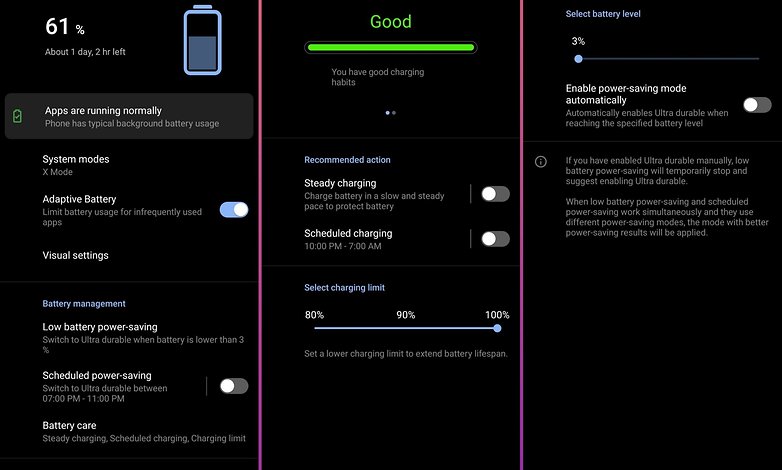
This year, there is a new setting known as "bypass charging" which allows the ROG Phone 5 to draw power directly from the charging pad and not from the battery itself. This purportedly helps reduce heating and should come in especially handy during lengthy gaming sessions.
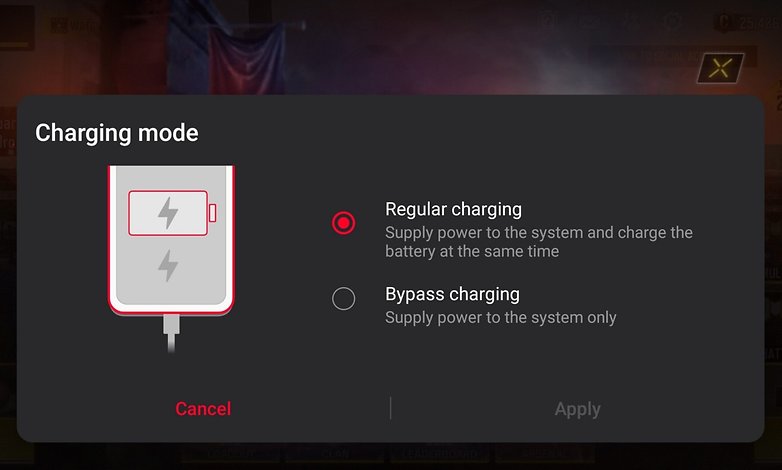
Overall, the battery life of the Asus ROG Phone 5 remains a top-tier performer where Android smartphones are concerned. The 6,000 mAh capacity perfectly handles all energy expenditure of this high specifications handset, with the fast charging optimized enough to never run out of juice as it conserves battery life.
Asus ROG Phone 5 specifications
Asus ROG Phone 5
| Specs | Asus ROG Phone 5 |
|---|---|
| Processor |
|
| Memory |
|
| Expandable storage |
None (no microSD slot) |
| Connectivity | 5G |
| Screen |
|
| Size | 172.8 mm, 77.2 mm, 10.29 mm |
| Weight | 238 grams |
| Camera |
|
| Video |
|
| Battery capacity | 6000 mAh (2 x 3000 mAh MMT) |
| Fast charging |
|
| Audio |
|
| IP certification | None |
| OS | ROG UI based on Android 11 |
| Price | from €799 |
Conclusion
The Asus ROG Phone 5 is undoubtedly the best Android smartphone for gaming purposes in 2021. With an entry price of €799, it's expensive for a high-end smartphone with an average performing 64MP camera module, but it's still cheaper than a OnePlus 9 Pro, vanilla Samsung Galaxy S21, or an Oppo Find X3 Pro while offering far better performance than those when it comes to multimedia content.
Rather than being a reviewer who wants to please everybody without upsetting anyone, I'll say that the ROG Phone 5 certainly targets a niche market for now, but they are deadly accurate. I'll repeat my seemingly heretical phrase: "Gaming is the new photography."
Like the camera module, the gaming segment and more broadly, the performance race is the next leap in smartphone innovation and competition where Android handsets are concerned. After all, aren't graphics benchmark scores already outranking DxOMark scores for photography when it comes to selling points?
Personally, I can accept this compromise of having average-looking photos if my smartphone allows me to play demanding games for hours on end without experiencing any loss of performance or having to stop simply because the smartphone has overheated to the point of burning my hands, or because of poor battery life that requires me to charge it.
I consider my smartphone as a multimedia tool, a channel for video content (games) and music consumption, as opposed to a photo-taking tool. I will always prefer power and battery life over beautiful photos, optical zoom performance, and fantastic night shots.
Yes, one can retort that it is overkill to having such a powerful device play mobile games. But isn't that the same as buying a €1,300 smartphone with five photo sensors to snap selfies for Snapchat and shoot 720p videos for TikTok?

